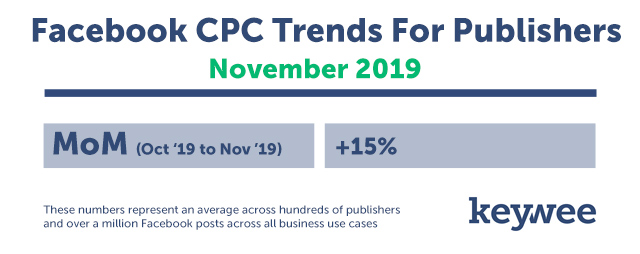We launched The Keywee Facebook CPC Tracker to help content creators understand how changes to the Facebook platform affect their daily work, based on our analysis of data from hundreds of publishers. Each month we release new data along with relevant insights on content distribution. You can read past months’ updates here.
To sign up for future CPC updates, fill out the form below:
November Recap
One trend that has dominated industry news for the past few years has been shaking up revenue mix to higher prioritize reader revenue, with a significant increase in overall share coming from paid subscriptions. From this, the prominent sub-trends to emerge in November were the rise of successful “micro-memberships” and the “unbundling of magazine subscriptions.” Both of these strategies depend on the financial support of small, loyal audiences that are willing to pay for access to specific content that often leans niche or offers a unique point of view or hook.
Example A: The hyperlocal Shawnee Mission Post, which has spent the past two years growing its paid subscriber count from the ground up to the point where it can support a full-time staff of three. The outlet credits much of its paywall success to two key decisions: trusting that the value of its hyper-local brand of journalism merritts readers pulling out their wallets, and then increasing the output of content that has a “lasting impact on the way that people live their lives” in the local area — a.k.a. the content that ultimately nudges readers to pay — such as ‘accountability journalism’ and introductory civics-style articles. Further evidence that these “micro-memberships” can bring in meaningful, sustainable income for small publishers came mid-month, when the crowdfunding platform Patreon announced that it had paid out over $1 billion to creators since its inception in 2013.
It’s not only small publishers hopping on this trend, though. In November, Esquire’s Politics With Charles P. Pierce celebrated its one-year anniversary by hitting the milestone of over 10,000 paying subscribers, each who pay $17.99 for an annual subscription. Around mid-November, Digiday reported that The The New York Times’ standalone Cooking and Crossword subscriptions brought in “$24.6 million in revenue for the first nine months of 2019, representing 7.8% of total revenues from all digital subscription products.”
Podcasts were also major drivers of news in November, which makes sense in light of the results of a recent study showing that share of time spent listening to spoken word audio has increased 20% since 2014. (Interesting and related fact: share of time spent with music decreased 5% during the same timeframe.) Netflix also announced its first original scripted podcast, “The Only Podcast Left,” which will serve as a companion story to its series “Daybreak” and takes place in the same post-apocalyptic universe as the streaming show.
November’s other big winners from the world of podcasting include:
- Slate, whose 25 podcasts now bring in half of overall revenue for the company
- Mobile devices, where 22% of listening to spoken word audio happened in 2019. A nice jump compared to 2014, when that number was only a single-digit of 9%.
- The overall industry, which, according to Forrester, will become a $1 billion media market by the end of 2020.
The last big November news trend that we’ll highlight for the penultimate CPC Tracker of 2019 is another mainstay from throughout the year: the rise (or perhaps, rebirth) of email newsletters. Overlapping with the rising prevalence of “micro memberships” that offer niche content, Lenfest Local Lab is aiming to bring a hyperlocal touch to local and regional newsletters, including a recently-launched pilot with The Philadelphia Inquirer. Elsewhere, advancements in newsletter personalization are helping publishers from across the pond in similar, yet different ways: Canada’s The Globe and Mail shared how contextually targeted content is vital to onboarding its readers, whereas The Financial Times in the UK considers personalization paramount to helping usher in a wave of paid digital subscriptions.
November Data
In November, we saw an uptick in Facebook CPCs, as prices increased by 15% month-over-month. While larger than the typically moderate price jumps that we see in other mid-quarter months, this increase coincides with the onset of the big holiday season in the US, a time when marketers have come to expect higher CPCs due to increased demand. Considering all use cases, we saw the most significant increases in the cost to develop audiences and, once again, campaigns promoting paid subscription sign-ups.
About Keywee
At Keywee, we make stories relevant and powerful for the world’s best storytellers — like The New York Times, The BBC, National Geographic, Forbes, and Red Bull.
Today, people aren’t coming to websites to search for content — stories find their audiences in feeds and apps. The upshot? Distribution is now the key for effective storytelling. Keywee’s platform unlocks audience insights using AI and data science, and infuses them into every step of the storytelling process: from topic selection, to story creation, to distribution and optimization.
Keywee is backed by leading investors such as Google’s Eric Schmidt and The New York Times, and has been a fast-growing, profitable startup since its inception. To learn more, request a demo here.


